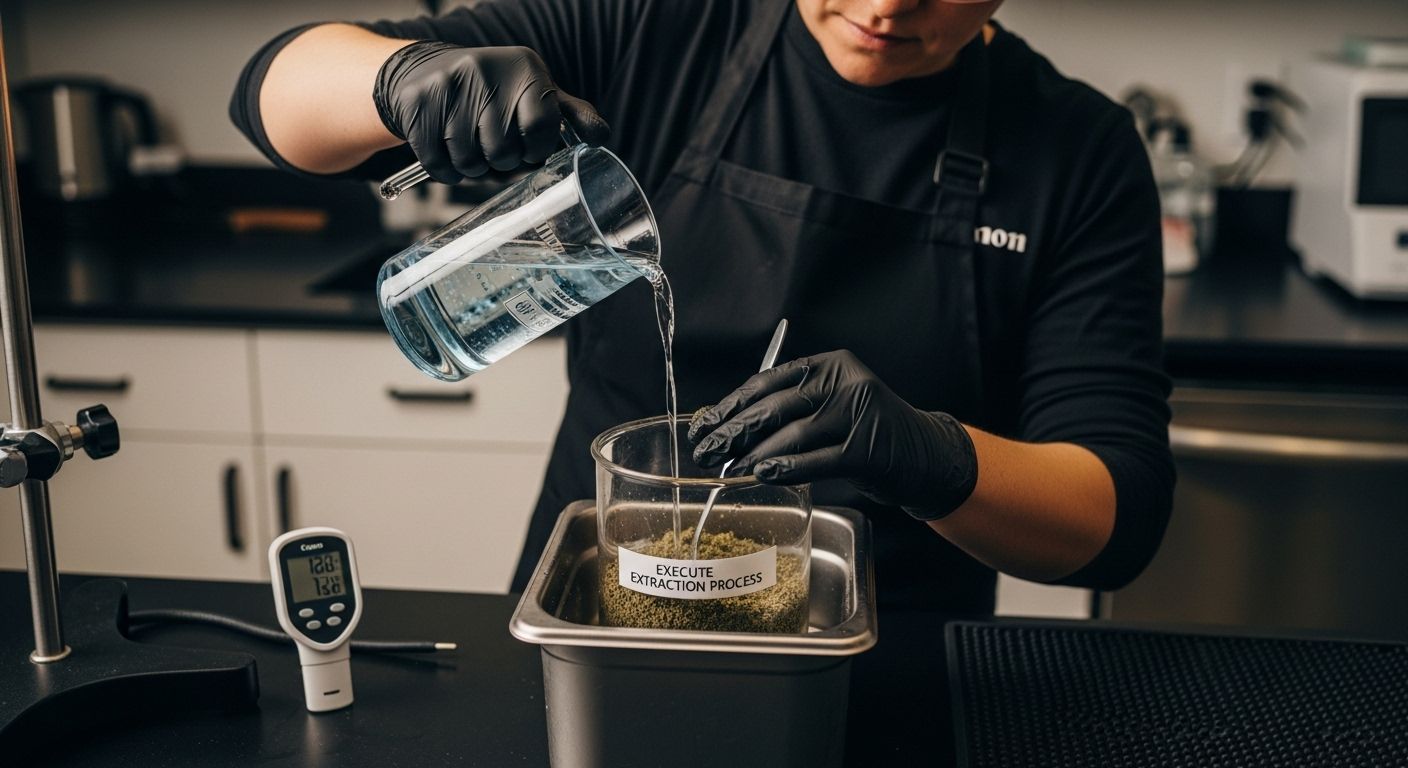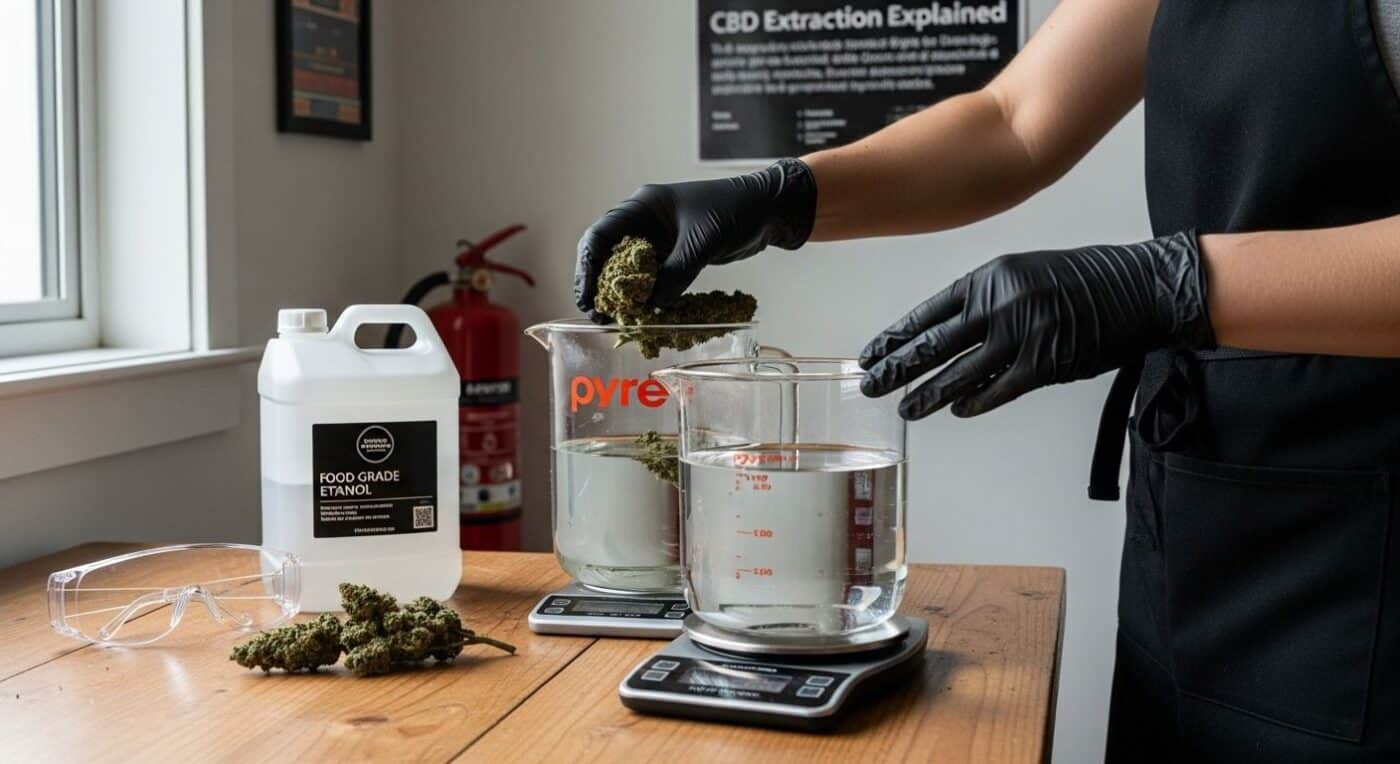Blog
Natural CBD Extraction Explained: Create Your Own 2025
Natural CBD extraction might sound complex, but the whole process can be done safely at home with the right approach. Forget expensive labs and industrial machines. Studies show percolation methods can pull out up to 80 percent of total CBD using food-grade ethanol. Most people are surprised to learn that choosing organic, well-cured hemp and keeping your ethanol cold are actually more important than fancy equipment if you want pure, potent results.
Table of Contents
- Step 1: Gather Necessary Materials And Equipment
- Step 2: Prepare Your Raw Cannabis For Extraction
- Step 3: Choose Your Extraction Method And Set It Up
- Step 4: Execute The CBD Extraction Process
- Step 5: Verify Extraction Quality And Purity
- Step 6: Store And Use Your Extract Safely
Quick Summary
| Key Point | Explanation |
|---|---|
| 1. Select Professional-Grade Equipment | Use high-quality tools like glass extraction vessels and vacuum pumps to ensure safety and efficiency during extraction. |
| 2. Prioritize Quality Hemp Material | Choose organic, pesticide-free hemp with verified cannabinoid content for best extraction results. |
| 3. Control Temperature and Environment | Maintain consistent room conditions around 68-72°F to enhance extraction efficiency and prevent contamination. |
| 4. Perform Decarboxylation and Grinding | Properly decarboxylate and grind cannabis for optimal cannabinoid extraction; avoid over-grinding for easier filtration. |
| 5. Store Extract in Dark, Air-Tight Containers | Use amber glass containers in cool, dark places to protect your CBD extract from light and air degradation. |
Step 1: Gather Necessary Materials and Equipment
Natural CBD extraction requires precise preparation and carefully selected equipment to ensure a safe, efficient process. Before diving into the extraction, understanding the necessary materials will set you up for success and help you navigate potential challenges.
Starting with equipment selection is crucial for achieving high-quality results. You will need several key pieces of specialized equipment that transform raw hemp into concentrated CBD. Professional-grade materials are essential for maintaining extraction integrity and preventing contamination.
For your extraction setup, you’ll want to collect the following primary tools:
- Large glass extraction vessel (pyrex or borosilicate glass)
- High-precision digital scale
- Food-grade ethanol or organic grain alcohol
- Fine mesh strainer or filtration bags
- Vacuum pump for solvent recovery
- Temperature-controlled heating plate or water bath
- Personal protective equipment (safety glasses, gloves, lab coat)
When selecting hemp materials, prioritize organic, pesticide-free hemp flower with verified cannabinoid content. Quality source material dramatically impacts your final product’s potency and purity. Research from the National Institutes of Health confirms that extraction efficiency directly correlates with starting material quality.
Consider environmental factors during your preparation. Your workspace should be clean, well-ventilated, and away from potential ignition sources. Ethanol is highly flammable, so create a controlled environment that minimizes risks. Temperature and humidity can also influence extraction, so aim for consistent room conditions around 68-72 degrees Fahrenheit with moderate humidity.
Professional tip: Always conduct a thorough inventory check before beginning. Missing even one critical piece of equipment can halt your entire extraction process. Document your materials, verify their condition, and ensure you have backup supplies if needed.
Below is a table summarizing the essential tools, materials, and protective equipment required for home-based natural CBD extraction, along with their specific purposes.
| Item | Specification or Type | Purpose |
|---|---|---|
| Glass Extraction Vessel | Pyrex or Borosilicate Glass | Holds cannabis and solvent during extraction |
| Digital Scale | High-precision | Measures accurate amounts of hemp and ethanol |
| Food-Grade Ethanol/Organic Grain Alcohol | 95% or higher proof | Primary solvent used to extract cannabinoids |
| Fine Mesh Strainer/Filtration Bags | Laboratory or kitchen-grade | Filters out plant material from extract |
| Vacuum Pump | Solvent recovery capable | Removes and recycles ethanol after extraction |
| Heating Plate or Water Bath | Temperature-controlled | Safely evaporates ethanol to leave CBD extract |
| Protective Equipment (Glasses, Gloves, Coat) | Chemical-resistant, lab-grade | Ensures user safety during chemical handling |
Step 2: Prepare Your Raw Cannabis for Extraction
Preparing raw cannabis for extraction is a critical process that transforms your plant material into a potent CBD source. This step determines the quality and efficiency of your final product, requiring precision and careful attention to detail.
Proper preparation begins with selecting high-quality, dried hemp flower that has been carefully cured and stored. Moisture content is crucial. Your cannabis should feel crisp and easily crumble when handled, indicating optimal dryness. Overly wet plant material can compromise extraction and potentially introduce unwanted microbial growth.
Decarboxylation represents the most significant preparation phase. This process activates the cannabinoids by converting their acid forms into bioactive compounds. Research from the National Institutes of Health demonstrates the importance of precise temperature control during this transformation.
To decarboxylate, spread your dried hemp flower evenly on a clean baking sheet lined with parchment paper. Preheat your oven to approximately 240 degrees Fahrenheit. Gently heat the cannabis for 30-40 minutes, stirring occasionally to ensure uniform activation. The material will turn from vibrant green to a more muted, brownish-green color, signaling successful decarboxylation.
After decarboxylation, grinding becomes essential. Use a clean, sharp herb grinder to create a consistent, fine particle size. Uniform grinding maximizes surface area, allowing more efficient cannabinoid extraction. Avoid over-grinding, which can create powder so fine it might pass through filtration systems.
Consider your grinding strategy carefully. Too coarse, and you’ll miss extracting valuable compounds. Too fine, and you risk creating a muddy, difficult-to-filter mixture. Aim for a texture similar to coarse sea salt – loose enough to allow solvent penetration but not so fine it becomes dust.
Once ground, store your prepared cannabis in an airtight, light-proof container. Keep it in a cool, dry place until you’re ready to begin the extraction process. Proper storage prevents degradation and maintains the potency of your carefully prepared plant material.
This table provides an at-a-glance overview of each main step in natural CBD extraction, highlighting the primary goal, approximate time, and key factors to watch for at each stage.
| Step | Main Action | Approx. Time | Key Considerations |
|---|---|---|---|
| Gather Materials & Equipment | Assemble tools, prep workspace | 10-20 minutes | Safety, inventory, preparation |
| Prepare Raw Cannabis | Decarboxylate and grind hemp flower | 45-60 minutes | Uniformity, dryness, not over-grinding |
| Set Up Extraction Method | Choose method, pre-chill ethanol, set up station | 20-30 minutes | Ventilation, temperature control |
| Execute Extraction | Mix cannabis with chilled ethanol, filter extract | 20-40 minutes | Gentle agitation, multiple filtrations |
| Verify Quality & Purity | Inspect, test, confirm extract characteristics | 10-15 minutes | Clarity, odor, basic potency check |
| Store & Use Extract | Transfer to dark glass, label, and store properly | 5-10 minutes | Light avoidance, airtight storage |
Step 3: Choose Your Extraction Method and Set It Up
Selecting the right extraction method is a pivotal moment in your natural CBD production journey. Each technique offers unique advantages and challenges, requiring careful consideration of your resources, desired product quality, and safety requirements.
Ethanol extraction emerges as the most accessible method for home and small-scale producers. This technique uses food-grade ethanol as a solvent to strip cannabinoids from plant material efficiently. The process involves submerging your decarboxylated cannabis in cold ethanol, which pulls out desired compounds while minimizing chlorophyll extraction.
Research comparing extraction techniques reveals that percolation methods can extract up to 80% of total CBD, making them significantly more effective than traditional approaches. When setting up your ethanol extraction, you’ll need a large glass container, high-proof food-grade ethanol, and a freezer to pre-chill your materials.
Your extraction setup requires meticulous attention to safety. Work in a well-ventilated area away from open flames, as ethanol is highly flammable. Wear protective equipment including chemical-resistant gloves, safety glasses, and a lab coat. Ensure your workspace is clean and organized, with all materials within easy reach.
Cold extraction technique involves freezing your ethanol to negative 20 degrees Fahrenheit before introducing cannabis. This method reduces unwanted lipid and chlorophyll extraction, resulting in a cleaner final product. Gently agitate the mixture, allowing the cold ethanol to wash over the plant material for approximately 3-5 minutes. Avoid over-extracting, which can pull unnecessary plant compounds.
After initial extraction, you’ll need to filter the mixture through fine mesh strainers or coffee filters to remove plant material. Multiple filtration passes improve clarity and purity. A vacuum filtration setup can expedite this process and provide more consistent results.
Finalize your method by preparing for solvent evaporation. Use a temperature-controlled water bath or rotary evaporator to carefully remove ethanol, leaving behind concentrated CBD extract. Monitor temperatures closely to preserve cannabinoid integrity and prevent degradation. Your goal is a clean, potent extract that reflects the careful preparation of your source materials.
Step 4: Execute the CBD Extraction Process
The CBD extraction process transforms your carefully prepared cannabis into a concentrated, potent extract. This critical stage requires precision, patience, and a methodical approach to ensure maximum cannabinoid recovery and product quality.
Begin by combining your decarboxylated, ground cannabis with pre-chilled food-grade ethanol in a large glass container. The temperature is crucial – aim to keep your ethanol between negative 20 and negative 40 degrees Fahrenheit. Cold temperatures minimize unwanted chlorophyll and lipid extraction, resulting in a cleaner final product.
Research comparing extraction techniques highlights the importance of systematic extraction methods. Gently agitate the mixture, allowing the cold ethanol to wash over the plant material. Use slow, consistent movements to prevent excessive plant material breakdown. Your goal is to create a thorough but controlled interaction between solvent and cannabis.
The extraction process typically takes 3-5 minutes of careful mixing. Avoid aggressive stirring, which can create emulsions and make later filtration more challenging. Watch for color changes – the liquid should transform from clear ethanol to a golden or amber hue, indicating successful cannabinoid extraction.
Filtering represents the next critical phase. Use a series of progressively finer filters to remove plant material. Start with a coarse mesh strainer, then move to coffee filters or laboratory-grade filter paper. Multiple filtration passes improve extract clarity and purity. A vacuum filtration setup can expedite this process and provide more consistent results.
Solvent removal requires precise temperature control. Use a temperature-controlled water bath or rotary evaporator to carefully eliminate ethanol. Maintain temperatures between 104-122 degrees Fahrenheit to preserve cannabinoid integrity. This step demands constant attention – too high a temperature can degrade your valuable compounds, while insufficient heat leaves residual solvent.
As the ethanol evaporates, you’ll see your extract concentrate.

The final product should be a thick, golden to amber-colored oil with a viscous consistency. Allow the extract to cool completely before storing in a light-proof, airtight container. Proper storage in a cool, dark place preserves potency and prevents degradation.
Step 5: Verify Extraction Quality and Purity
Quality verification represents the final critical checkpoint in your natural CBD extraction journey. This step transforms your raw extract into a reliable, safe, and potent product through meticulous testing and assessment.
Visual inspection provides the first layer of quality verification. A high-quality CBD extract should display a consistent golden to amber color with a translucent, viscous appearance. Any unusual cloudiness, dark discoloration, or particulate matter indicates potential contamination or improper extraction. Hold your extract up to natural light, examining its clarity and color uniformity.
Research from clinical cannabis quality frameworks emphasizes the importance of comprehensive product testing. While professional laboratory analysis offers the most definitive results, home producers can conduct several preliminary assessments.
Consider performing a simple purity test by observing how your extract interacts with different surfaces. Quality CBD extract should demonstrate specific characteristics: it should not leave significant residue when spread on parchment paper, should have a consistent viscosity, and should not separate into distinct layers when gently warmed.
Odor provides another critical quality indicator. Your extract should have a mild, earthy cannabis scent without harsh chemical undertones. Any strong solvent smell suggests incomplete ethanol evaporation and requires additional purification. A clean, subtle aroma indicates successful extraction and thorough solvent removal.
Home testing can include basic potency estimation. Invest in affordable cannabinoid testing strips designed for home use. These strips provide a rudimentary indication of CBD concentration, though they cannot replace professional laboratory analysis. They offer a quick, accessible method to confirm your extract contains active cannabinoids.
Store a small sample of your extract for potential future testing. Use an amber glass container with an airtight seal, keeping it in a cool, dark location. Proper storage prevents degradation and maintains extract integrity. Label your sample with extraction date, source material, and initial observations.
Remember that professional third-party lab testing remains the gold standard for comprehensive quality verification. If producing CBD for therapeutic or commercial purposes, consider submitting your extract for professional analysis to confirm cannabinoid profile, confirm absence of contaminants, and validate overall product quality.
Step 6: Store and Use Your Extract Safely
Proper storage and handling of your CBD extract represent the final crucial steps in preserving the quality and potency of your carefully crafted product. The method you choose can significantly impact the extract’s therapeutic potential and longevity.
Glass containers with airtight seals emerge as the gold standard for CBD extract storage. Amber or dark blue glass provides additional protection against light degradation, which can rapidly break down cannabinoid compounds. Avoid plastic containers, as they may leach chemicals that compromise your extract’s purity and interact with the cannabinoids.
Research from the National Center for Biotechnology Information emphasizes the critical role of environmental conditions in extract preservation. Temperature control becomes paramount. Aim to store your extract between 60 and 70 degrees Fahrenheit, with consistent humidity levels around 50-60%. A cool, dark pantry or dedicated storage cabinet works perfectly.
Light exposure represents a significant threat to your extract’s integrity. UV rays can rapidly degrade cannabinoids, reducing potency and altering the extract’s chemical composition. Create a dedicated storage space that minimizes light exposure. Consider using opaque containers or storing your extract in a light-proof container within a dark cabinet.
Labeling becomes an essential safety practice. Mark your container with the extraction date, source material, and initial potency assessment. This documentation helps you track the extract’s age and potential degradation. Include any relevant notes about the extraction process, such as the specific hemp strain or extraction method used.
When handling your extract, use clean, sterile tools to prevent contamination. Small glass dropper bottles with tight-sealing lids work excellently for both storage and controlled dispensing. Always use clean hands or sterile utensils when interacting with the extract, minimizing the introduction of moisture or external contaminants.
Consider dividing larger extracts into smaller portions for long-term storage. This approach prevents repeated exposure to air and potential contaminants. Each time you open the main container, you risk introducing moisture and oxygen that can accelerate degradation.
Regularly inspect your stored extract. Look for any changes in color, consistency, or smell that might indicate compromised quality. A well-stored CBD extract can maintain its potency for 12-18 months when kept under optimal conditions. Trust your senses – any unusual odor or significant color change suggests it might be time to dispose of the extract safely.
Ready for Premium CBD Without the Hassle?
After learning the careful steps required to create natural CBD extracts—sourcing organic hemp, proper decarboxylation, precise ethanol extraction, and strict quality control—you might feel inspired but also overwhelmed. The commitment to purity and safety is vital, yet the risks and equipment demand expertise and time many do not have. If you value exceptional quality, full-spectrum effects, and natural extraction, but want a faster, simpler way to experience CBD, there is a smarter option.

Discover Good Tide CBD Gummies, crafted with solventless hash rosin using natural extraction methods just like those described in the article. No confusing equipment or risky chemicals—just delicious, tropical-inspired gummies made for purity and enjoyment. Every batch is rigorously tested with visible lab results for your peace of mind. Visit our homepage to browse flavors, check reviews, and find out why so many choose our gummies for a trustworthy, effective CBD experience. Enjoy premium quality now, without the wait or worry. Shop today and treat yourself to authentic relaxation the natural way.
Frequently Asked Questions
What materials and equipment do I need for CBD extraction?
To successfully extract CBD, you’ll need materials like high-quality organic hemp, food-grade ethanol, a large glass extraction vessel, a precision scale, and protective equipment. Ensure your workspace is clean and well-ventilated.
How do I prepare raw cannabis for extraction?
Prepare your cannabis by decarboxylating it, which activates the cannabinoids. Spread the dried hemp flower on a baking sheet, heat it in the oven at 240°F for 30-40 minutes, and then grind it to a consistent texture to maximize extraction efficiency.
What is the best extraction method for producing CBD at home?
Ethanol extraction is one of the most accessible and efficient methods for home producers. It effectively extracts cannabinoids while minimizing unwanted chlorophyll, and it involves submerging decarboxylated cannabis in cold food-grade ethanol.
How can I verify the quality and purity of my CBD extract?
To verify quality, visually inspect the extract for color and clarity, perform a simple purity test by observing residue, and check for any unusual odors. For the most accurate results, submit the extract for professional laboratory analysis.
Recommended
- GOOD TIDE GUMMIES
- GOOD TIDE GUAVA GUMMIES
- GOOD TIDE KIWI STRAWBERRY GUMMIES
- GOOD TIDE PASSION FRUIT GUMMIES

